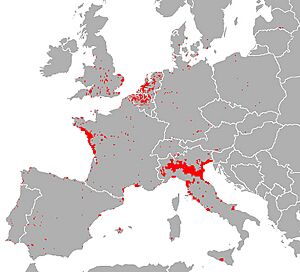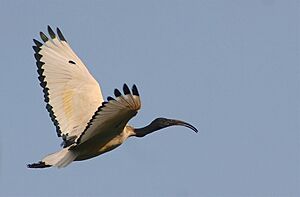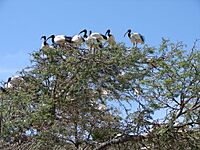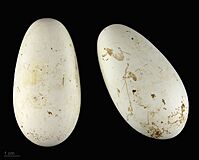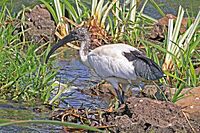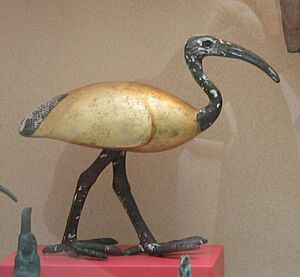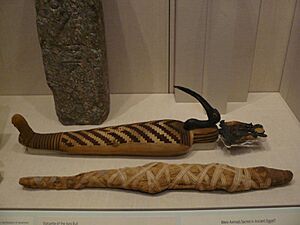African sacred ibis facts for kids
Quick facts for kids African sacred ibis |
|
|---|---|
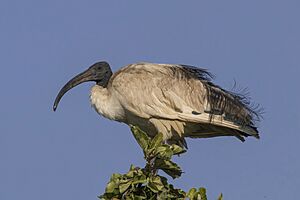 |
|
| in Ethiopia | |
| Conservation status | |
| Scientific classification | |
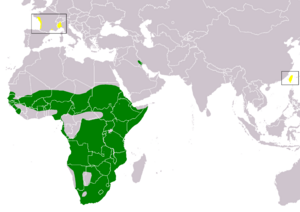 |
|
| Native and introduced ranges | |
| Synonyms | |
|
Tantalus aethiopicus Latham, 1790 |
The African sacred ibis (Threskiornis aethiopicus) is a type of ibis. It is a wading bird that belongs to the family Threskiornithidae. This bird naturally lives in most parts of Africa. You can also find it in small areas of Iraq, Iran, and Kuwait. It was very important in Ancient Egyptian religion, linked to the god Thoth. Sadly, this bird no longer lives in Egypt.
Contents
What is the African Sacred Ibis?
The African sacred ibis is closely related to the black-headed ibis and the Australian white ibis. These three birds are so similar that some scientists think they might be the same species. They can even have babies together if they are in the same group.
For a long time, people in Europe didn't know about ibises. They thought old writings about them were talking about other birds. But in the 1700s and 1800s, scientists like John Latham and George Robert Gray studied these birds. They gave the African sacred ibis its modern scientific name, Threskiornis aethiopicus.
What Does the African Sacred Ibis Look Like?
Adult African sacred ibises are about 68 centimeters (27 inches) long. Their body feathers are all white, but they have dark feathers on their back near the tail. Their wings can spread from 112 to 124 centimeters (44 to 49 inches). They weigh about 1.35 to 1.5 kilograms (3 to 3.3 pounds). Males are usually a bit bigger than females.
Their head and neck have no feathers and are black. Their thick, curved beak and legs are also black. When they fly, you can see a black edge on their white wings. Their eyes are brown with a dark red ring around them. Young ibises have dull white feathers and a smaller beak. They also have some feathers on their neck.
This bird is usually quiet. Sometimes, it makes sounds like a puppy yelping. This is different from its noisy relative, the hadada ibis.
Where Do African Sacred Ibises Live?
Where are they from?
The sacred ibis breeds in Sub-Saharan Africa and southeastern Iraq. Some groups of these birds move with the rainy seasons. For example, some birds in South Africa fly 1,500 kilometers (930 miles) north to Zambia. Birds north of the equator fly south. The group in Iraq usually flies to southwestern Iran for winter.
Africa
These birds used to live in North Africa, including Egypt. In ancient Egypt, people often honored and mummified them for the god Thoth. For many centuries, temples buried thousands of these birds every year. People thought there were special farms to raise ibises for these offerings. However, by 1850, the species had disappeared from Egypt.
The species did not breed in southern Africa before the 1900s. But it has grown in numbers because of irrigation, dams, and farming. These practices create more places for them to live and find food. It started breeding in the early 1900s. Now, it is common in most parts of South Africa.
Elsewhere in Africa, it lives throughout the continent south of the Sahara Desert. However, it is mostly absent from very dry deserts and rainforests. It is common in eastern and southern Africa.
Asia
The bird also lives in Yemen. In 2003, many bred on small islands near Haramous. They also bred along the Red Sea coast near Hodeidah and Aden. They were often found at places that clean wastewater.
The species was common in Iraq in the early 1900s. But by the late 1960s, there were very few left. Their numbers dropped a lot when the Mesopotamian Marshes were drained. However, they have been seen breeding in the Hawizeh Marshes since 2008. It is also native to Kuwait, but it is very rare there. Small numbers of these birds have been seen in Iran since the 1970s.
Where have they been introduced?
The first African sacred ibises came to Europe in the mid-1700s. In the 1800s, some birds escaped from zoos. In the 1970s, many zoos let their birds fly freely. These birds would find food nearby but return to the zoo at night. This led to wild populations in places like Italy, France, Spain, Portugal, the Netherlands, the Canary Islands, Florida, Taiwan, and the United Arab Emirates.
Some studies say these introduced birds can affect the environment and economy. Other studies suggest they don't harm native European birds much.
Europe
In Europe, the African sacred ibis is now on a list of "Invasive Alien Species." This means it cannot be brought in, bred, or released in the European Union.
In France, wild populations grew along the Atlantic coast. These birds came from a zoo. By 2005, there were about 1,100 breeding pairs. A program was started to reduce their numbers. By 2017, the population was much smaller.
In Spain, the species is not considered established. Birds that escaped from the Barcelona Zoo were later removed. Now, any birds coming from France are shot.
In Italy, a population grew from a zoo or possibly from France. By 2008, there were an estimated 80–100 breeding pairs. They often fed in rice fields. Control efforts are not well-coordinated in Italy.
In the Netherlands, sacred ibises escaped from zoos and private collections. By 2007, there were 15 breeding pairs. However, after a cold winter and efforts to recapture them, their numbers dropped. By 2010, there were no more birds breeding in the wild.
Other Places
On the Canary Islands, sacred ibises are kept in zoos. Some have been seen in the wild near the zoos, but their breeding is controlled.
In the United Arab Emirates, ibises were introduced to Sir Bani Yas Island. They also escaped from Al Ain Zoo. By 2010, the population in Al Ain was over 75 birds. They are often seen in parks and villages.
In Taiwan, birds escaped from a zoo before 1984. By 2016, there were an estimated 1,000 individuals. The government started a program to remove them. By August 2021, over 16,000 birds had been removed.
In Florida, five birds escaped from Miami Metro Zoo after Hurricane Andrew in 1992. Their population grew to 30 or 40 by 2005. A decision was made to remove them. By 2009, 75 birds were removed, and they are believed to be gone from Florida.
How Do African Sacred Ibises Live?
What is their habitat?
The African sacred ibis lives in marshy wetlands and muddy areas. These can be inland or near the coast. They like to build nests in trees near water. They find food by wading in shallow water or walking slowly in wet fields. They also visit farms and rubbish dumps.
What do they eat?
These birds are predators and usually hunt during the day in groups. They mainly eat insects, worms, crabs, snails, and other small creatures. They also eat fish, frogs, reptiles, small mammals, and dead animals. They can use their long beaks to dig in the soil for earthworms. Sometimes, they even eat seeds.
Sacred ibises have been seen eating eggs of other birds, like pelicans and cormorants. In France, they often eat an invasive type of crayfish. In winter, they might eat food from rubbish tips.
Who are their predators?
The main predator of young sacred ibises in Kenya is the African fish eagle. These eagles often attack the largest groups of ibis nests. However, in Ethiopia and South Africa, eagles are less of a threat.
What diseases do they get?
African sacred ibises can get diseases like avian botulism and avian cholera. A new type of bacteria, Chlamydia ibidis, was found in some wild ibises in France in 2013. Scientists have also found different types of worms and parasites in these birds.
How Do African Sacred Ibises Reproduce?
The African sacred ibis usually breeds once a year during the wet season. In Africa, they breed from March to August. In Iraq, it's from April to May. They build nests out of sticks, often in baobab trees.
They nest in colonies, which are large groups of birds. They often share these colonies with other large wading birds like storks and herons. Sometimes, they form groups only of ibises on islands or old buildings. Nests on islands are often built on the ground. Large colonies can have thousands of birds.
Females lay one to five eggs per season. Both parents take turns sitting on the eggs for 21 to 29 days. After the chicks hatch, one parent stays at the nest for the first seven days. The young birds learn to fly after 35 to 40 days. They become independent after 44 to 48 days. They can start having their own babies when they are one to five years old.
-
The breeding colony in Montagu, Western Cape, South Africa
-
Immature sacred ibis, Uganda
How are African Sacred Ibises Protected?
The IUCN lists the African sacred ibis as "Least Concern". This means it is not currently in danger of disappearing. The world population is thought to be between 200,000 and 450,000 birds. However, their numbers seem to be going down. This bird is protected by an agreement called the Agreement on the Conservation of African-Eurasian Migratory Waterbirds (AEWA).
African Sacred Ibis in Ancient Stories
For many centuries, ancient Egyptians mummified sacred ibises. They offered them to the god Thoth. Thoth was the Egyptian god of wisdom, knowledge, and writing. The sacred ibis was seen as Thoth living on Earth. People from all over Egypt brought thousands of ibis offerings to temples. It is believed that about eight million ibises were mummified by the ancient Egyptians.
People used to think that special farms raised these ibises for mummification. But studies of their DNA suggest that most of the birds were caught from the wild. The mummified birds were often young. Their necks were usually broken, and food was sometimes placed in their beaks. The mummies were stored in jars, wooden chests, or stone boxes. Not all mummies had whole birds; some only had a leg or an eggshell.
Ibis mummification started around 1,100 BC and stopped around 30 BC. It was most popular during the Late Period and Ptolemaic Period of ancient Egypt.
Ancient writers like Herodotus and Pliny the Elder wrote about the ibis. They said the ibis helped protect against flying serpents. Herodotus wrote that ibises would meet these serpents from Arabia and kill them. This is why Egyptians honored the ibis so much.
Josephus wrote that when Moses led the Hebrews to fight the Ethiopians, he brought ibises in cages. This was to help against any serpents they might meet.
Pliny the Elder also said that flies carrying sickness would die if an ibis was sacrificed. Some ancient authors even believed that ibises reproduced using their beaks, meaning they were always virgins!
Pliny and Galen believed that the ibis invented the clyster (enema). They said the bird used it to treat hippopotami.
In ancient Rome, the worship of Isis became popular. The ibis became one of her symbols. You can see these birds in old paintings and mosaics from Pompeii and Herculaneum.
Some translations of the Bible say the ibis is an unclean bird that should not be eaten.



